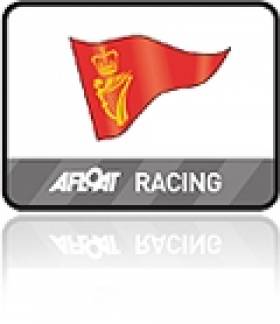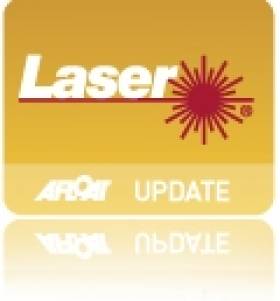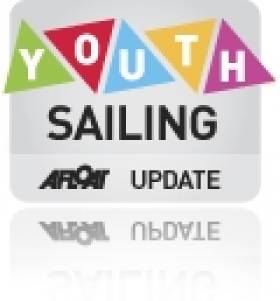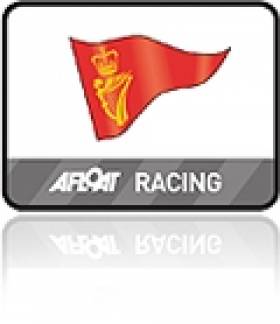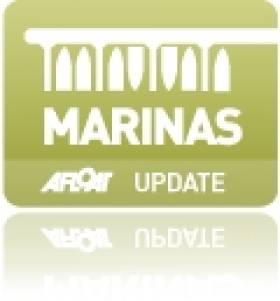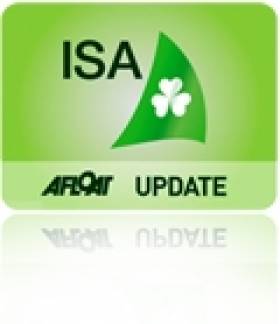Displaying items by tag: Royal Cork Yacht Club
#royalcork – Last night Royal Cork Yacht Club (RCYC) celebrated its stand out achievement of incredible sailing programmes from high performance events to grass roots initiatives when the Mitsubishi Motors Sailing Club of the Year trophy was brought home to the Crosshaven clubhouse. The award – which was announced in March at the Afloat Sailor of the Year awards in Dublin – was presented to members at a clubhouse party where already early season RCYC achievement from 2015, such as Anthony O'Leary's double success on the Solent, was also toasted.
Afloat's WM Nixon in handing over the Ship's wheel trophy, in a competition that is now 36–years–old, commended Royal Cork organisers of the well-established and highly regarded Volvo Cork Week international racing event, on its adaptation of entry costs and time commitment to make the event more accessible. While the Women's World Match Racing event demonstrated excellent organisation and show cased Ireland and Cork harbour as a desirable World class sailing event destination.
Their members also tasted glory at junior and youth levels with Séafra Guilfoyle's silver medal at the ISAF Youth Worlds in Portugal as one of the standout performances of Irish sailors in 2014. At grass roots RCYC started their ISA Women on the Water Ireland with an entire week of taster sessions in different types of boats at different times of the day, to give local ladies a chance to give a try, then followed up with dedicated coaching for adults to work on their sailing skills.
Their commitment to quality and high standards is second to none and they have a special dedication to fulfilling the needs of their members from organising extra coaching for the keen young members to skippers information nights for the cruising sailors.
There were four nominations for Club of Year and it was a close call between them as each has proven to provide incredible support to Irish sailing in 2014, other nominees were Royal Irish Yacht Club, Baltimore Sailing Club and Galway Bay Sailing Club.
More on this in tomorrow's WM Nixon Sailing on Saturday Blog
#laserulsters – Royal Cork's Nick Walsh was the winner of the Ulster Laser Championships staged by Lough Erne Yacht Club in the last weekend of April. The three rig event provided racing for 4.7s, radials and full rigs. After six races over the two days in light and fickle conditions (with the odd 20knt squall thrown in for good measure) Royal Cork's Richard McGinley was crowned Ulster 4.7 Champion with three firsts, a second and sixth (discarding an OCS). Clubmate Nick Walsh was also crowned Ulster Champion in the Standard Rig with five firsts and a second. The radial title also went to the south coast with Ciaran Finnegan of Waterford Harbour Sailing Club winning by four clear points from Strangford Lough's Laura Gilmore. Full results are downloadable below as a pdf file.
#cruiserracing – Can you successfully incorporate a full-blown National Championship into an established neighbourhood regatta? We're going to find out from June 24th to 27th, when the ICRA Nationals and the Sovereigns Cup in Kinsale are combined into one four day event, the result of the joint efforts of two sets of organisers and administrators. W M Nixon takes a look at how this situation has developed and discovers four of the top men in the marine and sailing scene have significantly different views as to how big regattas and the ICRA Nationals should be staged.
The Irish Cruiser-Racer Association emerged from an attitude of complete realism about the contemporary sailing scene in 2002. Back then, the Irish economy was starting to develop a head of steam, and people were buying potent performance-cruisers which just begged to be raced offshore. Yet changing social attitudes meant that the traditional concept of an offshore racing crew being prepared to spend seven or eight long weekends away every summer campaigning the boat in classic offshore races simply wasn't acceptable in the new world of shared family responsibilities.
But the short-lived ideal of making classic offshore racing more family-friendly was also soon seen as unattainable except for those few extra special family crews – we can all think of one or two examples - whose very uniqueness in their shared enthusiasm for rugged offshore sailing day and night only serves to emphasise that what they like doing is simply not for the majority of sailing families.
For sure, we admire them without reservation. But we know that it won't float our family's boat. For although the totality of Irish "cruiser-racers" in 2002 included several out-and-out racing machines which were vigorously campaigned inshore and offshore, the reality is that most of the fleet were the sailing equivalent of those 4x4 SUVs which block up the parking in many a leafy and affluent suburb.
Usually, the most adventurous outing such vehicles will go on is the daily school run. There's no way their loving owners plan an aggressive demonstration of their pride-and-joys supposed off-road ability. But they do seem to find it reassuring to know that if for some reason they suddenly have to go across rough terrain, the vehicle can manage it even if the driver is scared stiff. And of course, in the unlikely event that a horse-box needs to be towed – well, no problem......
So, thirteen years ago as sailing's equivalent of the SUV began to take over marinas, two leading figures in sailing administration realised that, far from changing the new increasingly family-oriented way of doing things and forcing boats well capable of going offshore to do so even if their crews didn't particularly want to, what was needed instead was a new kind of event to suit the way that most people wanted to sail with their new performance cruisers.
The late Jim Donegan of Cork, Commodore of the South Coast Offshore Racing Association, was ocean racing aristocracy – his grandfather Harry owner-skippered the 18-ton cutter Gull to third place overall in the first Fastnet Race in 1925, and consequently became one of the founder members of the Ocean Racing Club which six years later in 1931 became the RORC, while Jim himself was to go on to win many an offshore contest.
Fintan Cairns of Dun Laoghaire has given generously of his energy and time over the years to sailing both as an active participant, a race officer, and an administrator – he was Commodore of Dublin Bay Sailing Club at a period of its healthiest expansion. Like Jim Donegan, in 2002 he was hugely enthusiastic about racing boats with lids, and he loved the offshore game. Yet in the Autumn of 2002, the two of them convened a national assembly in Kilkenny in order to form an organization whose primary aim would be to create the kind of event that would be attractive to the new generation of cruiser-racer owners, people whose boats could go offshore, but preferred the nice regatta atmosphere and home-to-port-at-the-end-of-the-day format.
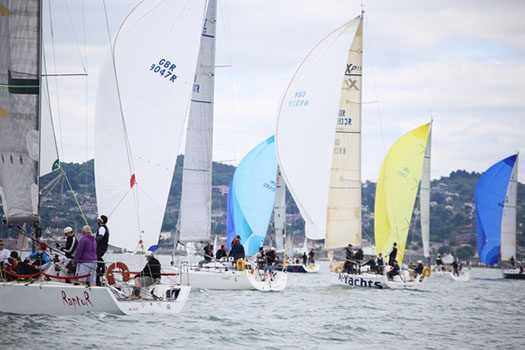
A nice regatta atmosphere, and back to port at the end of the day.....the racing in the ICRA Nationals 2014 at the Royal Irish YC in Dun Laoghaire neatly captures the purpose of the organisation as envisaged by the founders in 2002. Photo: David O'Brien
Thirty-one years earlier in 1971, the Irish Sea Offshore Racing Association had been formed by enthusiasts like Hal Sisk of Dun Laoghaire and Dickie Richardson of Holyhead on the assumption that their new organisation should be related to an area of good and extensive racing water, and for a while it worked very well. At its peak, ISORA was attracting a total entry of 107 different boats from all arts and parts into their annual season-long championship in which – if you were intending to be a serious contender – you had to think of racing at least seven events.
That meant seven weekends which, in some cases, inevitably meant leaving your home port on the Thursday and maybe not getting back until Monday morning or even later. Fine and dandy in its day, but its day didn't last too long. Maybe fifteen years in all. By then, new attitudes to family life and a tendency to concentrate one's sailing on a few big events combined with other less time-consuming smaller local events, meant that the ISORA model was no longer valid.
Yet boat numbers in ports kept increasing, so the Irish Cruiser Racing Association came into being at that November meeting in Kilkenny in 2002 to provide Irish-based regattas which, in some cases, would involve trailing the smaller boats to distant venues still on the island of Ireland, instead of sailing them many miles to others ports across the channel.
For old salts, the idea of an offshore racing association based on a land mass, and the notion of road-trailing offshore racers across that land mass to a regatta, seemed absurd. But this was only the beginning of it. For unless there was an unexpected demand for it, the new ICRA programme had no plans to include any overnight sailing except where it involved the training up an Irish Commodore's Cup team, as this was soon within ICRA's ambit.
Basically, what it meant was that ICRA's purpose was to organize an annual national championship regatta of four days at one of Ireland's main sailing centres, chosen on a rotational basis, they would also honour a "Boat of the Year", and every second year they would assemble a Commodore's Cup team.
Far from owners being faced, as they were in the old days, with the challenging demands of preparing a boat for offshore racing and then assembling an experienced crew from a panel in which the ideal number would be twice the number required to crew the boat, instead they were now offered an agreeable pattern of day sailing at some pleasant venue, and much socialising with it, while the results were efficiently calculated by ICRA's travelling road show of race administrators and number crunchers.
Yet for anyone who thought this wasn't really quite rugged enough, there was ruggedness-by-association with the Commodore's Cup campaigns. And all this went particularly well as the Irish economy went stratospheric from 2002 until 2008, so much so that at one stage Ireland actually fielded three different Commodore's Cup teams which even had the luxury of competing against each other. There's posh for you......
But it was too good to last, and ironically the economy had already fallen off a cliff in 2010 when a very serious single team Irish Commodore's Cup campaign, carefully led by Anthony O'Leary, finally won the Commodore's Cup. Also during 2010, the ICRA Nationals in late May were hosted by the Royal St George YC in Dublin Bay, which provided immediate access to the largest fleet of cruiser-racers in Ireland. Thus numbers were easily kept up to a respectable level and in all – the brutal recession notwithstanding – it was a great year for ICRA, with the 2010 Commodore Barry Rose, who had also been the Commodore's Cup Team Manager, deservedly accepting the Mitsubishi Motors "Irish Sailing Club of the Year" award after this great season.
But inevitably, things were more subdued for the next three years as the longterm ill-effects of the recession took hold. So though ICRA Nats were held in Crosshaven in 2011, Howth in 2012, and Fenit on Tralee Bay in 2013, resources were so scarce that the decision was taken not to attempt a defence of the Commodore's Cup in 2012.
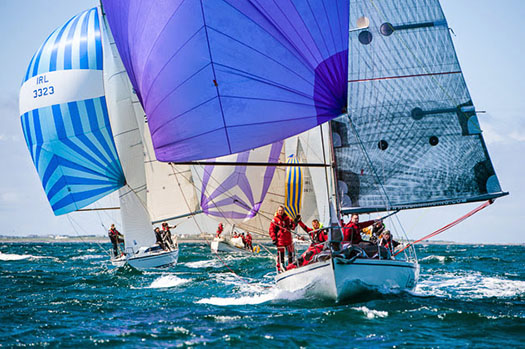
The images which came back from the ICRA Nationals 2013 in Tralee Bay suggested good sailing, but for two days the stormy weather caused a complete shut-down. Photo: Bob Bateman
When one cornerstone is removed, others are examined in more detail. The 2013 ICRA Nationals in Tralee Bay had the misfortune to coincide with a period of very unsettled weather which emphasised the fact that many of the top boats had travelled a long way by both sea and land to this gallant outpost of the Irish offshore racing scene to link up with their WIORA counterparts. But although some spectacularly sunny photos of racing in strong winds and bright sunshine emerged, the reality is that they barely had two days of viable competition as the rest of the programme was blown out in utterly miserable storm conditions.
Coming as it did at a time when the economy was barely faltering back into life, this unlucky outcome led to it being open season for suggestions as to the way ahead. There were those who wondered if people's seemingly ever-decreasing sailing time might be better used if the ICRA Nationals were combined into some established events, pointing out that a natural annual rhythm was already there with the biennial Volvo Cork Week rotating with the biennial Volvo Dun Laoghaire Regatta to provide easy access for large local fleets.
When set against the all-Ireland idealism of the founders, this was anathema to many, as the stand-alone national event, with the effort made to go anywhere in Ireland where you could find substantial local cruiser-racer fleets, was seen by some as central to the ICRA ethos.
However, things were put on hold during 2014 with a well-supported if locally-emphasised ICRA Nationals hosted by the Royal Irish YC in Dublin Bay in June, and then in July there was a mighty victory in the Commodore's Cup 2014 in a wonderful effort built around quiet background work by team captain Anthony O'Leary.

ICRA Nats 2014 in Dublin Bay saw a popular win in Class 0 for the Phelan family's Ker 36 Jump Juice from Crosshaven. Photo: David O'Brien
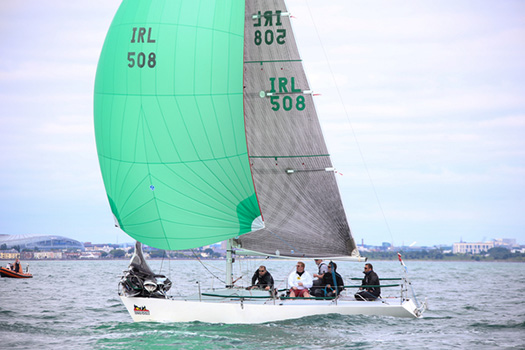
Jonathan Skerritt's vintage Quarter Tonner Quest of the host club was overall winner of the ICRA Nats 2014 at the RIYC. Photo: David O'Brien
But meanwhile, faced with the reality of the recession in sailing, ICRA's senior number cruncher Denis Kiely had quietly been putting out feelers about the possibility of combining the 2015 ICRA Nationals with Kinsale YC's biennial Sovereigns Cup regatta, which has been trundling along since 1995. By the time the great 2014 season was fully under way, it was no secret that this arrangement for 2015 was already in place, thereby guaranteeing – it was hoped – a substantial increase in numbers in 2015 and better overall value for the sailing community, while at the same time taking the ICRA Nationals to another new venue.

The perfect sailing in the 2013 Sovereign's Cup at Kinsale inspired ICRA officers to seek the link-up for the ICRA Nationals 2015 with the Sovereigns Cup 2015. Photo: Bob Bateman
At first glance, it seemed eminently sensible. But not everyone agreed. It was towards the end of an engaging interview with Commodore's Cup winner Anthony O'Leary at the end of July last summer in his beloved Royal Cork YC, just four days after he and his team had received the trophy on behalf of Ireland on the Royal Yacht Squadron lawns in Cowes, that I witnessed the first significant shot going across the bows of the good ship ICRA/Sovereigns of Kinsale.
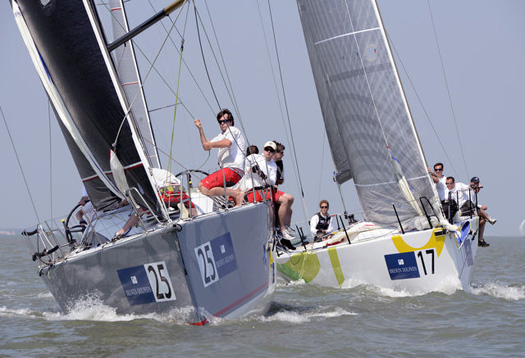
Team Captain Anthony O'Leary's veteran Ker 39 Antix hanging in there to stay ahead of a newer Ker 40 to lead Ireland to victory in the 2014 Commodore's Cup. Photo: Rick Tomlinson
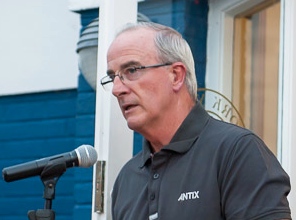
Someone whose considered opinion has to be taken seriously – Anthony O'Leary in thoughtful mood as he speaks at a reception to welcome the Commodore's Cup back to the Royal Cork YC. Photo: Bob Bateman
Anthony O'Leary was quite clear in his mind as to how the Irish cruiser-racing scene should go forward. And just as you should never get into a row with people who buy ink by the barrel, equally you wouldn't dream of openly disagreeing with someone who has just pulled Irish sailing out of the doldrums, so I just sat still and let this broadside roll over me.
"I think it's a mistake to incorporate the ICRA Nationals in the Sovereigns Cup in Kinsale....." he said bluntly. "The Sovereigns is one of my favourite regattas, but it's a friendly intimate business. While the town may have the infrastructure ashore, the marina is always crowded and I don't see how the kind of fleet they hope to attract will be comfortably accommodated there".
"Then too" he continued, "we already have two major alternating four day regattas in Dun Laoghaire and Cork Harbour. It's time to accept that sailing people are seeking to focus on fewer major events, and to give a more compact annual programme their best shot. So let's see how it would work if the ICRA Nationals simply rotated between Volvo Cork Week and the Volvo Dun Laoghaire Regatta".
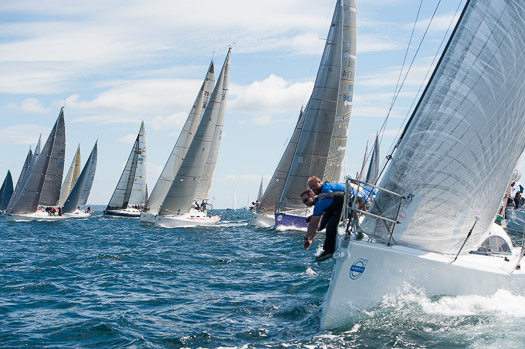
Clean close racing at Volvo Cork Week 2014. There's a line of thought that reckons this regatta could comfortably incorporate the ICRA Nationals. Photo: Bob Bateman
You can see how, in the circumstances, this idea seemed vibrant and immediately attractive. But more recently in an interview with another equally renowned sailor, Tim Goodbody who is Chairman of the Volvo Dun Laoghaire Regatta Committee 2015 there was something said which gave further pause for thought.
Tim Goodbody was totally clear in his own mind about the thinking behind the successful VDLR concept and its ability to provide viable racing for 31 different classes, and as he has helmed to victory both inshore and offshore to the highest levels, while also proving himself a master at designing courses for Dublin Bay, his views carry every bit as much weight as those of Anthony O'Leary.
"You have to remember it's a regatta, not a championship" said Goodbody. "Enjoyment of sport comes first, and the purity of fierce competition second. But of course we're going to provide the best possible starts. And the intention is to have those starts leading into the best possible courses in the conditions prevailing"
"Yet the way we see it, people should be racing just as soon as possible after leaving the harbour. There's nothing which impairs simple sailing enjoyment so much as having to wait around in a perfectly good but maybe fickle sailing breeze, hanging about in frustration while an overly-pernickety Race Officer dithers over setting the absolutely perfect start line".
In the context of the fun-filled suburban sailfest which is the VDLR, that's a perfectly reasonable approach. But is it a proper approach for something which aspires to call itself a National Championship? I rather doubt it, and there's no way the VDLR claims to be a national championship even if the numerous GP 14 Class are calling their enthusiastic participation in the VDLR 2015 the class's "Leinster Championship".
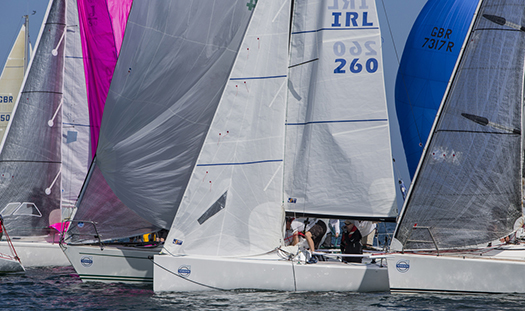
Everyone getting in everyone else's way, but that's part of the fun. The laid-back approach of the Volvo Dun Laoghaire Regatta as seen at 2013's event. Photo VDLR
For, in terms of boat size, the GP 14s will be among the smaller craft taking part in the VDLR, and they can find their own space. However, if you were campaigning a large cruiser-racer in one of the ten IRC classes which have to share the waters of Dublin Bay with 21 other boat classes during VDLR, would you expect to have your part of the event designated as the ICRA Nationals? On the contrary, if you were seriously concerned about the overall good of Irish sailing, you'd probably rightly think this was a spurious claim for what is essentially a fun event.
We were still mulling over the deeper meaning of Tim Goodbody's words in relation to Anthony O'Leary's opinions when this week another big beast in the sailing sphere, Minister for the Marine Simon Coveney no less, also launched into the choppy waters to be met with by those who would hope to rationalise the sailing programme into fewer but bigger international-standard events.
As he was speaking aboard the Naval Service's LE Eithne in Dublin's River Liffey at a reception to boost this summer's joint ICRA Nationals/Sovereigns event in Kinsale, it will be no surprise to learn that he was strongly in favour of it, so perhaps he reckons – unlike Anthony O'Leary - that Kinsale can cope with a substantial influx of visiting boats.
"Two events like this combined at the same time in one venue give extra strength" he said. "I want to see sailing in Ireland become much more ambitious in combining resources to create events which will have true international standing. This is a sport we should be really good at, both in participation and in staging events of world stature. Combining medium-sized events and regattas into one much bigger event like this one in Kinsale is going to be for the long-term good of Irish sailing in particular, and Ireland in general. The planned event is now expected to generate at least €800,000 extra income for the Kinsale area during the regatta period, while there's continuing beneficial spinoff for this harbour town which has added significance as the southern terminal and start point for the Wild Atlantic Way".

Norbert Reilly, Commodore of ICRA, with Minister for the Marine Simon Coveney at this week's reception aboard LE Eithne in Dublin to promote the combined ICRA Nats and Sovereigns Cup 2015 at Kinsale from 24th to 27th June. Photo: David Branigan
Doubtless we'll be getting spinoff of a different kind about these Ministerial views from the many people around the coast who work long and hard to keep alive those quirky little local regattas and special neighbourhood sailing and boating events which will never be major happenings of international stature, but are an essential part of the fabric of our many and varied maritime communities, and are deeply attractive for discerning visitor who shun crowds and seek out quiet enjoyment.
But as it is, aboard the Eithne we had yet another viewpoint to put into the cauldron of developing opinion, as the concluding speech was made by Nobby Reilly, current Commodore of ICRA. In a conversation with him before he made his speech, Nobby emphasised that the ICRA Nationals 2016 will be a stand-alone event once more, and he can be fairly certain about that, as the venue will be his own home port of Howth.
In the light of this, it should be remembered that in his blunt no-nonsense way, Nobby has done great work in encouraging newcomers into sailing. Earlier this week, I happened to be with some keen sailing folk from Wicklow including David Ryan – Farmer Ryan - whose remarkable Monster Project campaign of racing a Volvo 70 in Wicklow's Round Ireland Race 2014 had drawn on the efforts of Nobby Reilly and ICRA with their Let's Try Sailing campaign last May. This resulted in four wannabe sailors from remote parts of Ireland getting their first taste of the heavy metal with the Monster, and we'll see a film of it on RTE and other channels in due course, after the heroic task of cutting 147 hours of tape down to one hour has been completed.
But in the meantime, Nobby concluded the shipboard reception for this year's ICRA Nationals-with-the-Sovereigns-in-Kinsale with a spot of unexpected banter. "Maybe" says he, "maybe we should stop being concerned about trying to convince people that sailing is inexpensive. For we all know that, as it's a vehicle sport, there's bound to be basic expenditure over and above what you'd get with straightforward athletics and team sports. So maybe we should encourage people to get their kids to take up sailing on the grounds that if they come to like it, then there's no way they'll have the money to do drugs....."
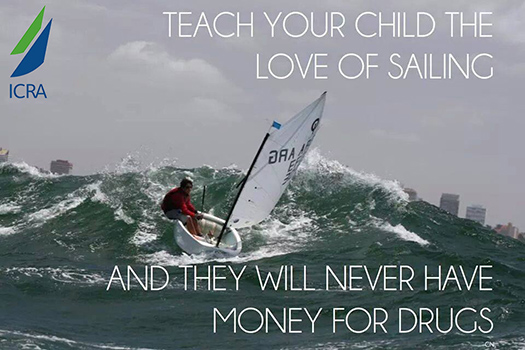
ICRA Commodore Nobby Reilly's positive response to the perceived costliness of sailing
Read also:
Should Irish Cruiser Racing (ICRA) Championships Stand Alone? (July 2013)
The Commodores' Cup – How Ireland Won It & Where It Might Go From Here (August 2014)
Youth Sailing Champions Are Saluted at Royal Cork Yacht Club
#youthsailing – Sunday turned out to be a miserable morning with winds gusting 30 knots at Roches Point and resulted in Principal Race Officer Peter Crowley cancelling all racing for the four youth sailing Classes writes Claire Bateman. Consequently, prize giving for these fleets was moved forward to 1.30 pm and facilitated an early journey home for the competitors.
In the Topper Class Geoff Power of Waterford Harbour Sailing Club took first place with a four point lead, while Luke McElwaine of Newcastle Yacht Club/Carlingford Lough Yacht Club came in second, only one point ahead of Tom Keal of Royal Cork Yacht Club in third place. First female Topper sailor was Caoimhe Foster of the host club, who came in fourth overall, only one point behind third place. The Toppers only managed four races over all in the event due to adverse weather. These results will be part of the basis for choice to compete for the Topper Summer Squad and the final decision on the full squad will be made in the coming weeks.
In the Laser 4.7 class the winning sailor was Henry Higgins of Royal St George Yacht Club and overall second placed sailor and winning female sailor was Rebecca O'Shaughnessey of Royal Cork Yacht Club with third place going to Conor Quinn of Carlingford Lough Yacht Club. This is an indicator event for the 4.7 ISA squad for the summer, along with other event results.
The performance of the Laser Radial girls at this event has to be noted, with five girls in the top ten and Erica Ruigrok of Rush Sailing Club coming in at third place, also giving her the first female result. Conor O'Beirne gave the most consistent performance over the nine races and gained first place. Second place went to Cian Byrne of Royal Cork Yacht Club who showed good local knowledge of winds and tides and used them to his advantage.
There was an extremely tight battle for first place in the 420s between Douglas Elmes and Colin O'Sullivan, of Royal Cork Yacht Club and Howth Yacht Club, and Peter McCann and Harry Whitaker, also Royal Cork, who took the overall prize. James McCann also Royal Cork, with Bill Staunton of Skerries Yacht Club as crew, was hot on the tail of his elder brother throughout the event and finished in third place. Lizzy McDowell and Anna O'Regan of Malahide Yacht Club were not far behind and took fourth place and first female position.
Meanwhile the wind had abated and shifted to the North and enabled racing to commence for the hardy optimists and this was particularly important in that places were up for grabs for the Worlds Team, the European Team and a Development Squad. Two races were sailed giving them a total of thirteen races over the event.
Top scoring Optimist in the Trials was Micháel Ó Suilleabháin KYC followed by Harry Bell of HYC second, followed by Gemma McDowell of MYC in third place.

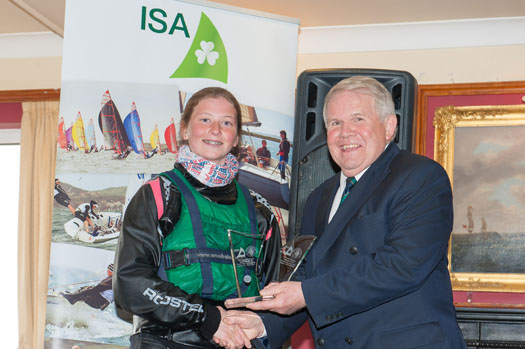
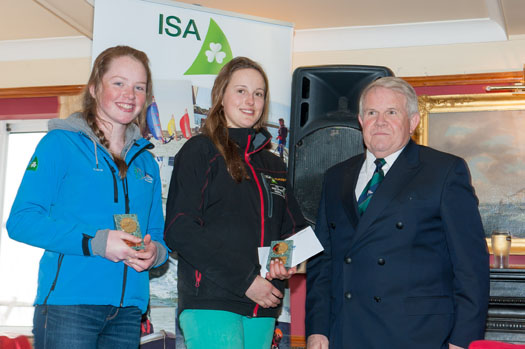
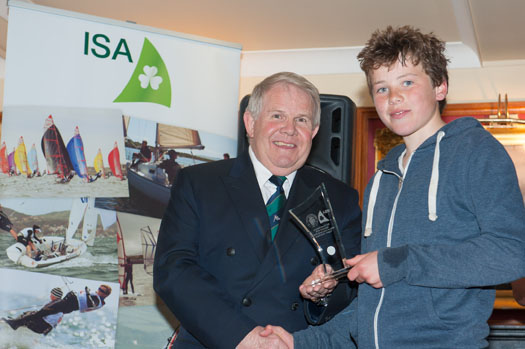
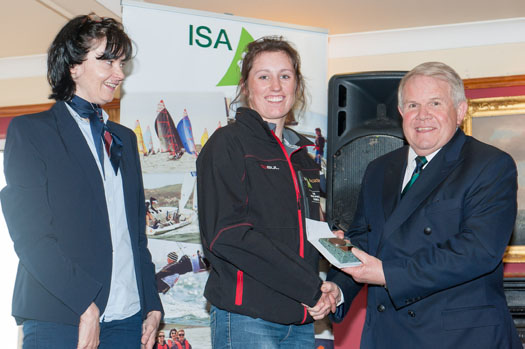
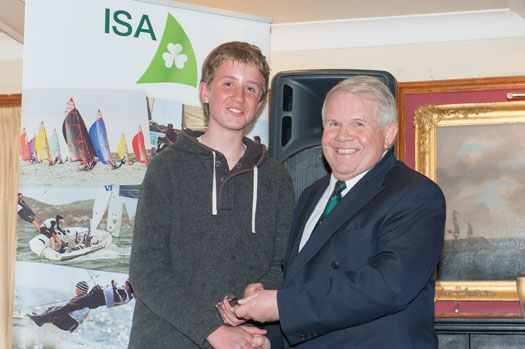

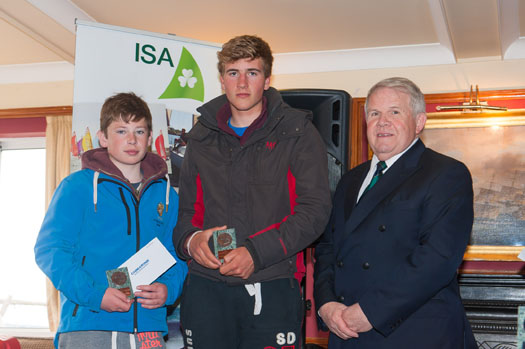
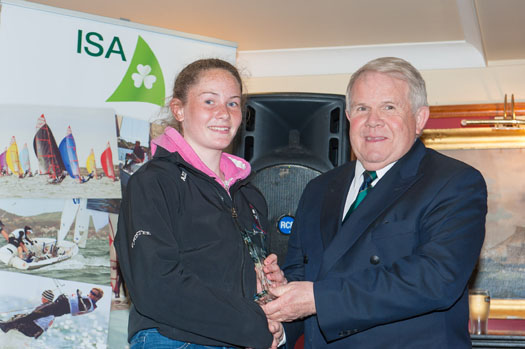
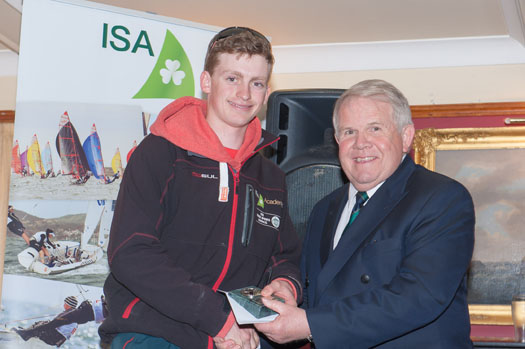

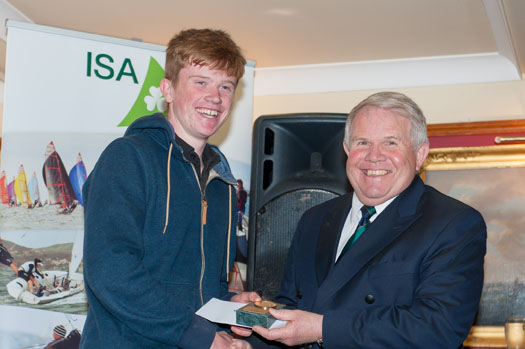
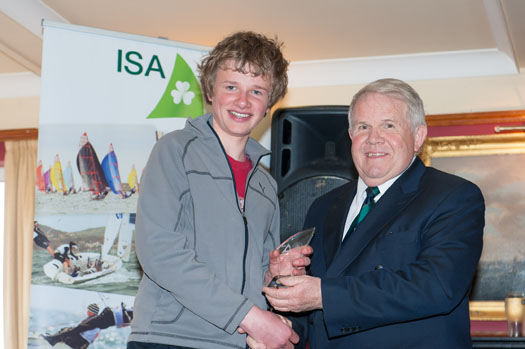
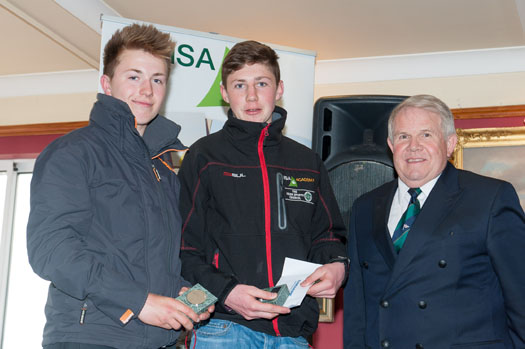
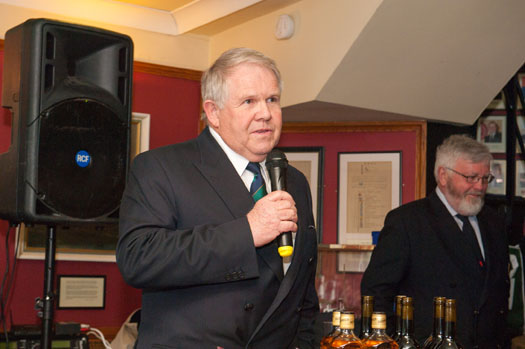
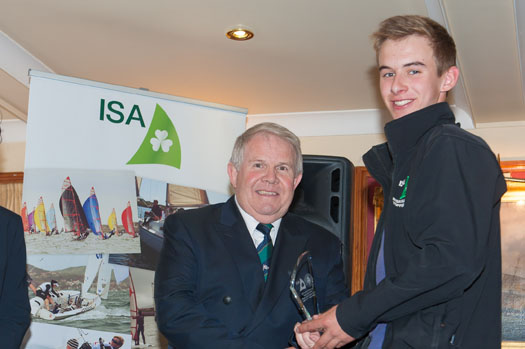

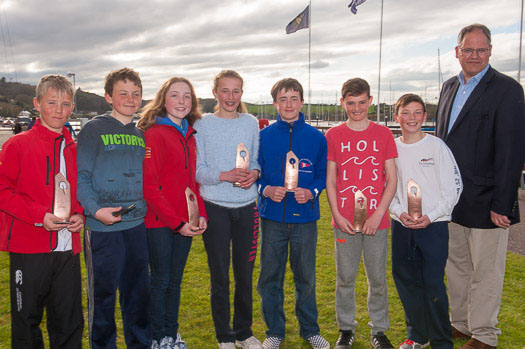

Radials & 420s Start Youth Nationals At Royal Cork
#youthnationals – Today saw the first day of racing at the ISA Pathway Trials and Youth Sailing Championships at the Royal Cork Yacht Club writes Claire Bateman. Today's fleets were Laser Radials and 420s. The Principal Race Officer was Alan Crosbie. The morning turned out to be foggy but there was a light south easterly breeze and the sun made an appearance making it into a pleasant day but still retaining some heat haze.
During the day the wind strengthened slightly and went more into the east with Alan Crosbie weaving his magic by sailing the 420s on the outer loop of a triangular course while the Radials sailed on the inner loop. For the next three days the fleets will be joined by the Toppers and the Laser 4.7s.
Meanwhile, not a mile away on the Curlane Bank, Race Officer Anthony O'Leary was performing his style of magic in enabling the IODAI Optimist Trials also to get in three races. There was no doubt he got the best of the wind from his position as it was somewhat stronger on this course and he got in three fine races for the sixty plus competitors and the races were over forty minutes each for two of them with the third being over fifty minutes.
The IODAI Optimist Trials will run over 4 days from today (Thurs) to Sunday. This is a qualifying event for the Optimist sailors to represent Ireland in 2015 - the top five at Optimist Worlds in Wales, next seven at Optimist Europeans in Poland and a number of sailors chosen for a development team that will sail at the French Nationals.
The 420s and Laser Radials are competing in the ISA Youth Pathway Nationals from today (Thursday,) while the Toppers and Laser 4.7s will compete from tomorrow, Friday to Sunday. Normally this is a qualifying event for the Youth Worlds, which are usually in the summer, but the 2015 Youth Worlds are in Malaysia in December which is a little too far away. Still an important event for all the classes as the Lasers compete for the honour of ISA Youth Pathway Nationals Champion, the 420 sailors are qualifying for the Junior Europeans and Worlds, while the Toppers are qualifying for the ISA Summer squads which will build up their skills for the Topper Worlds in Lake Garda. This is an open event for ALL Topper, 420, Laser 4.7 and Laser Radial sailors, which means the young sailors did not have to qualify to enter and it gives ALL sailors a chance to compete against each other on an even playing field.
All in all an excellent, if somewhat long day for the youth competitors but obviously scintillating and provided for plenty of chatter and camaraderie when coming ashore and bringing their boats back to the allotted compounds for each fleet.
Racing continues tomorrow (Friday).
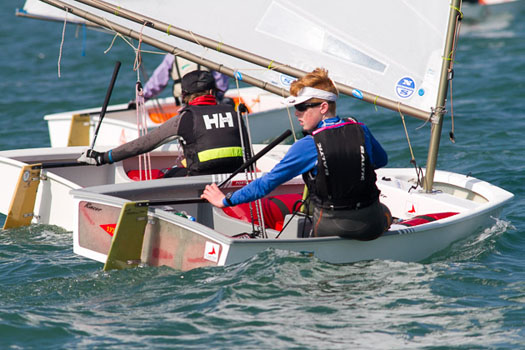

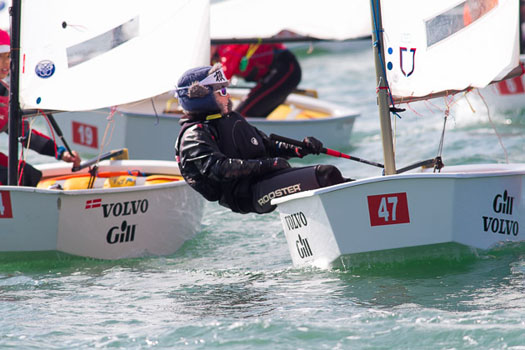

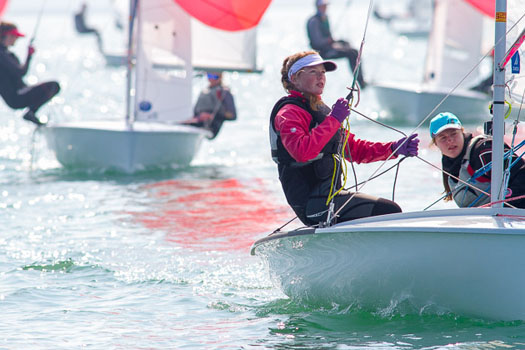
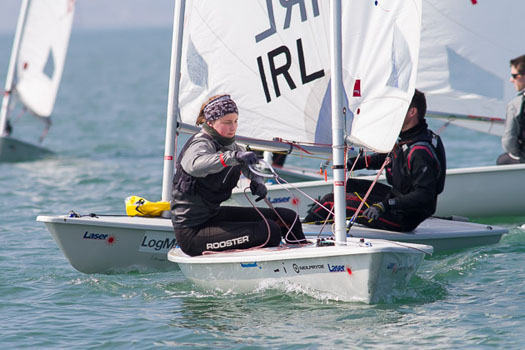
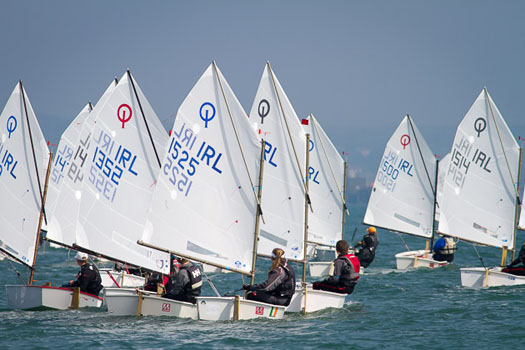
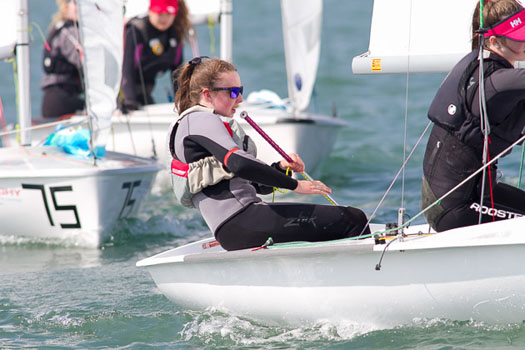

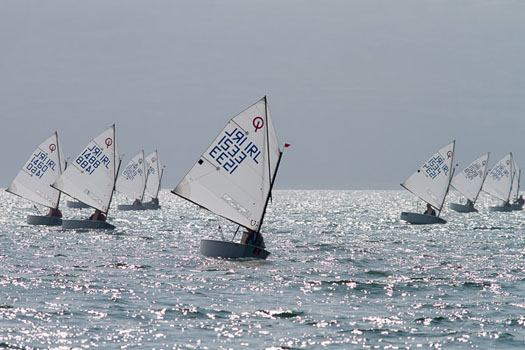
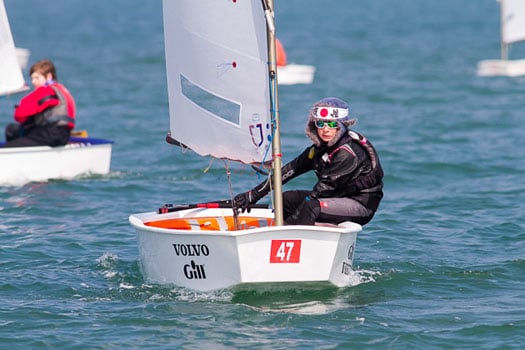
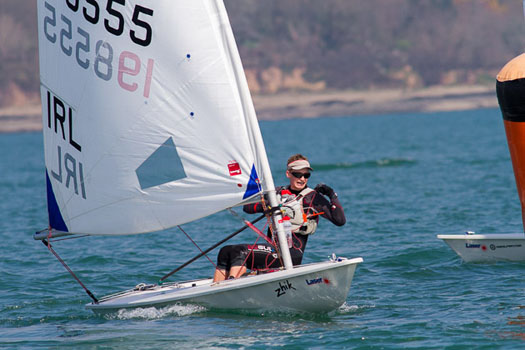
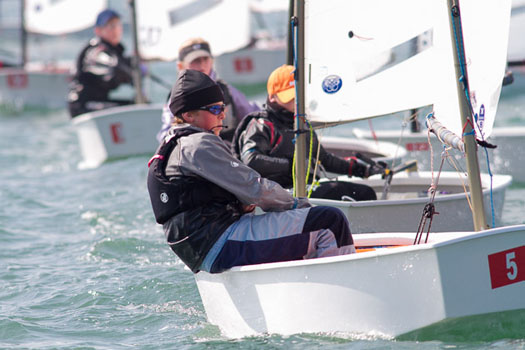
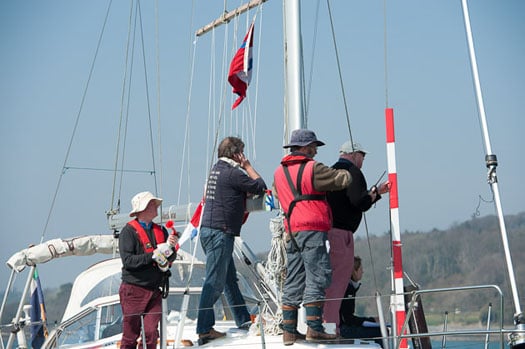


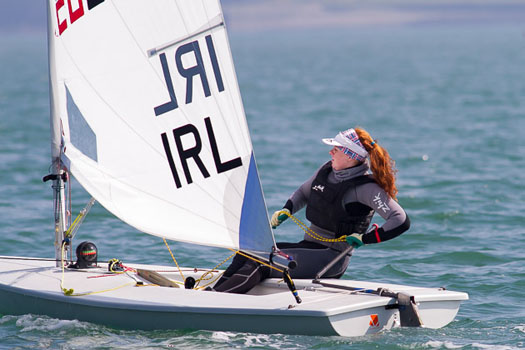
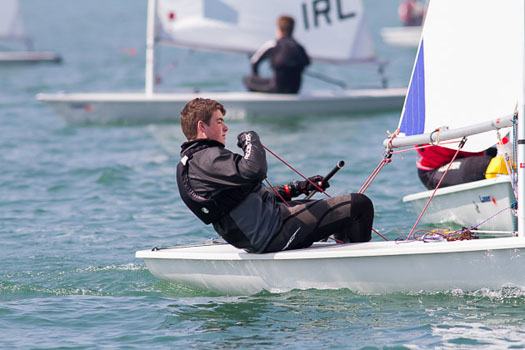
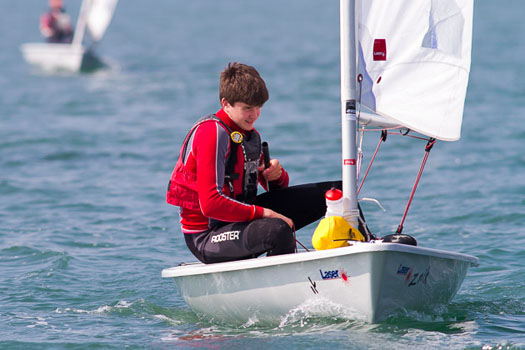
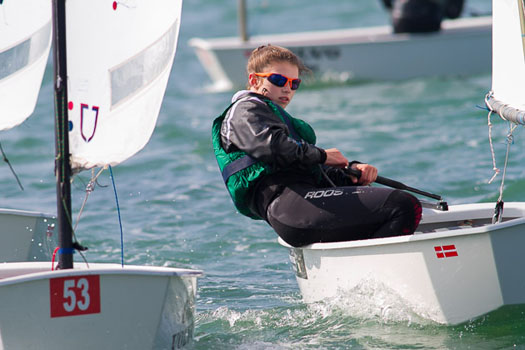
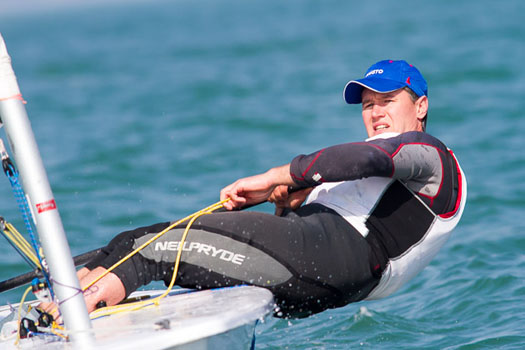
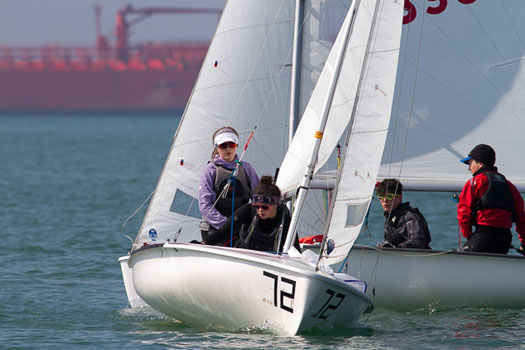
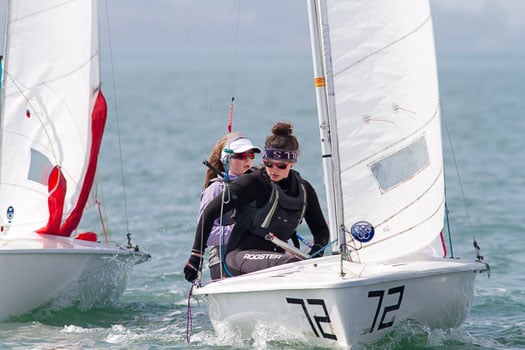
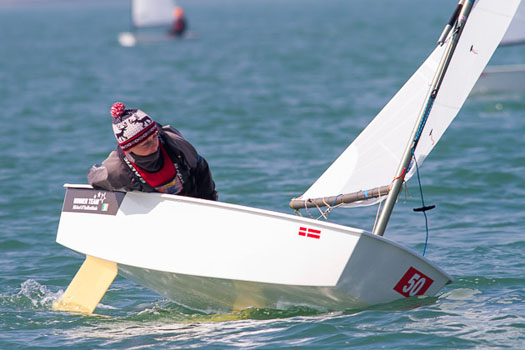

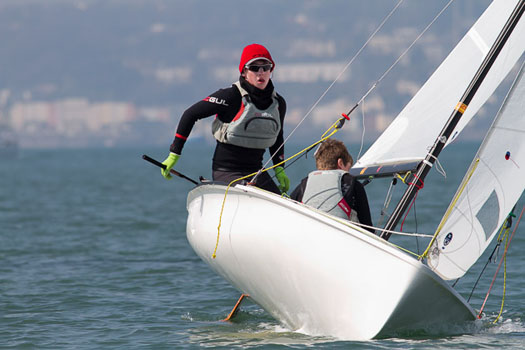

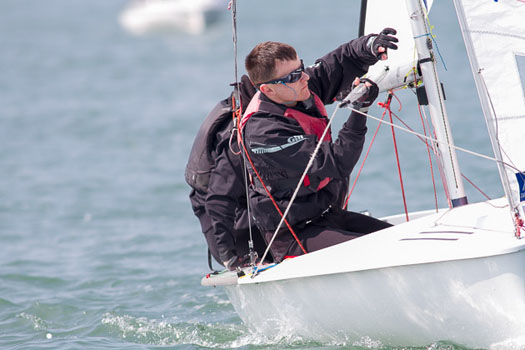
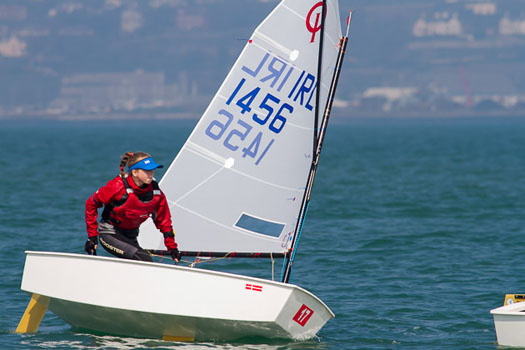
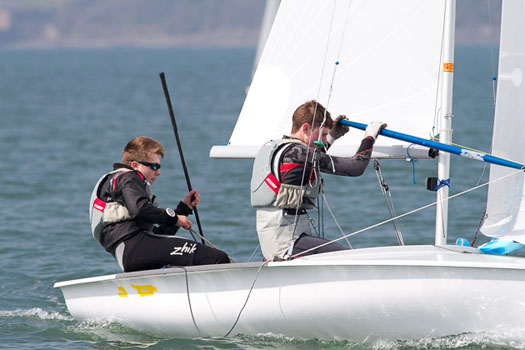



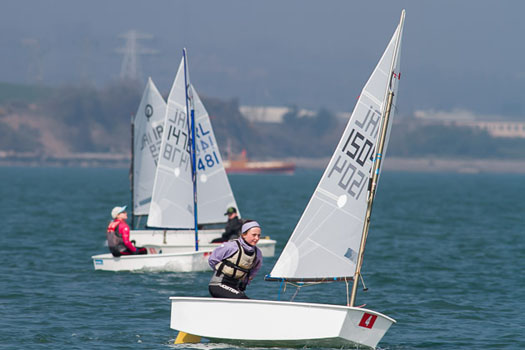
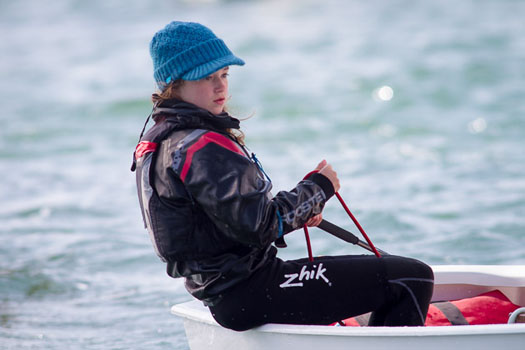
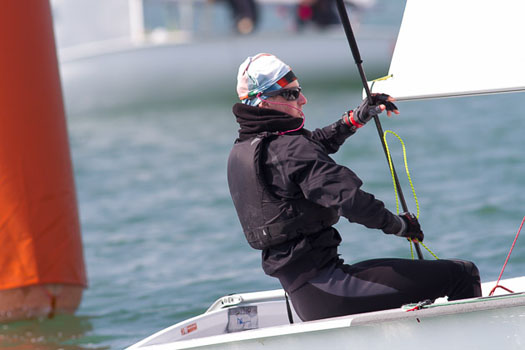
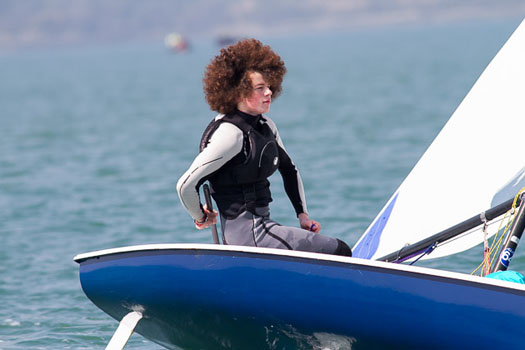
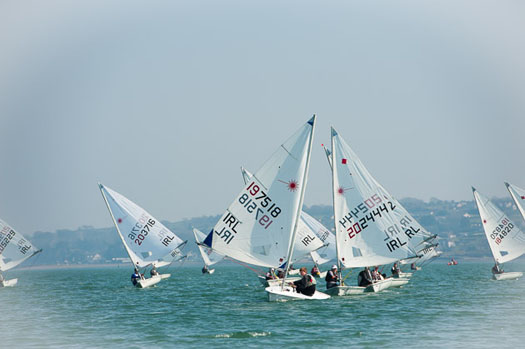

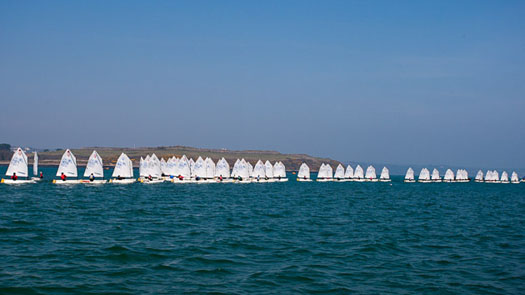
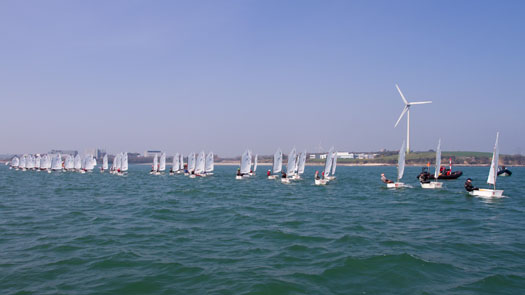
#youthsailing – The Youth Sailing Nationals for Topper, 420, Laser 4.7 and Laser Radial will be hosted by Royal Cork Yacht Club from tomorrow, Thursday 9th to Sunday 12th April 2015. This is an open event for all sailors in these classes writes Claire Bateman.
Today at the RCYC the air was filled with excited chatter and greeting of friends arriving from all over Ireland. Conditions were ideal with bright sunshine and sailors quickly got down to the last minute preparations and checking of their gear. The Optimists were weighed and they had their sails stamped.
The ISA Youth Pathway Nationals will be the selection trials (or part of) for National squads and an indicator (amongst other events) for the Academy. Classes sailing will be 420, Laser Radial, Laser 4.7 and Topper. The IODAI 2015 Optimist Trials will be held in conjunction with, but sailed on a separate course from the Championships. There will not be an Optimist fleet in the ISA Youth National Championships 2015. Tomorrow Thursday the Laser Radials and 420s will commence racing. Tomorrow will also see the beginning of the Optimist four day IODAI Trials with Anthony O'Leary Afloat Sailor of the Year as Race Officer, and Friday will see the commencement of racing for the Topper and Laser 4.7 fleets.
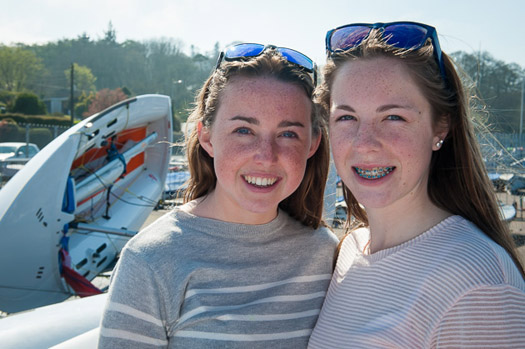

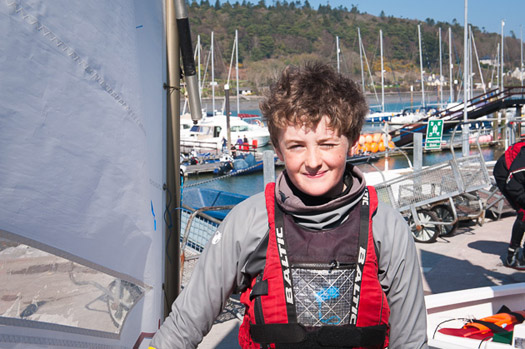

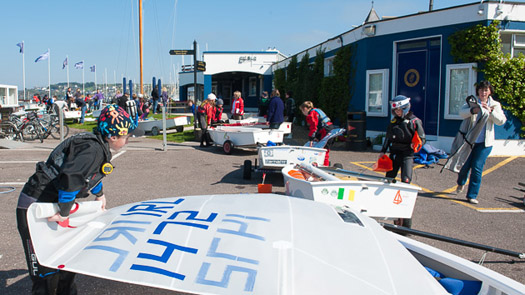
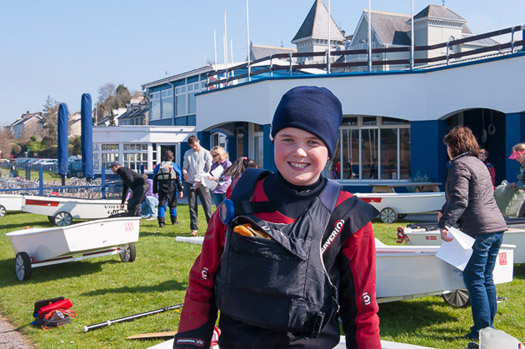
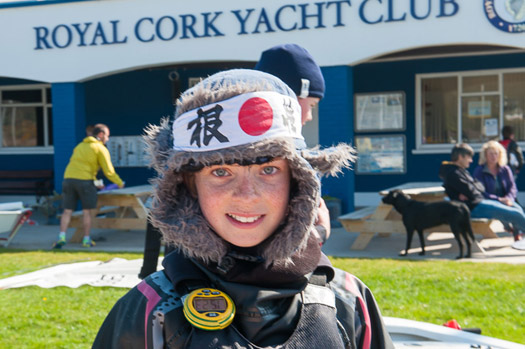
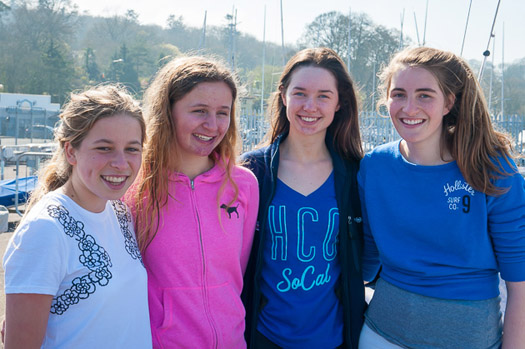
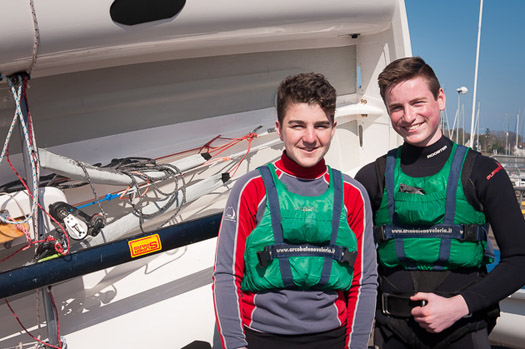
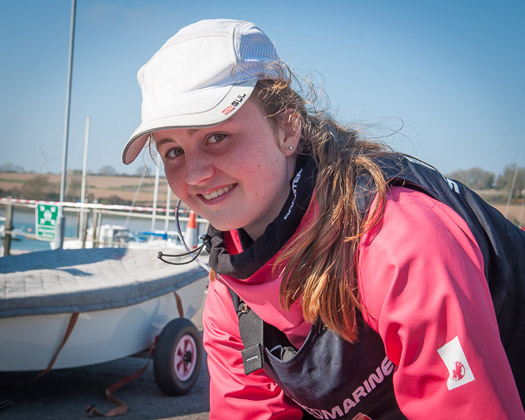
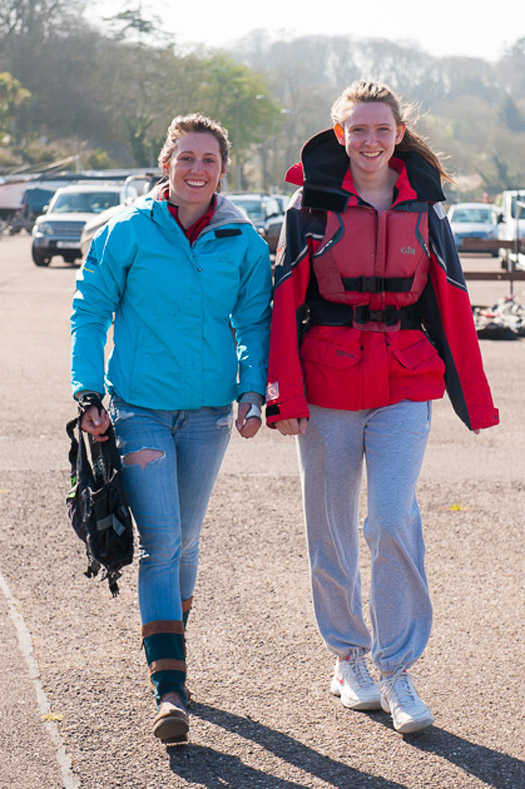
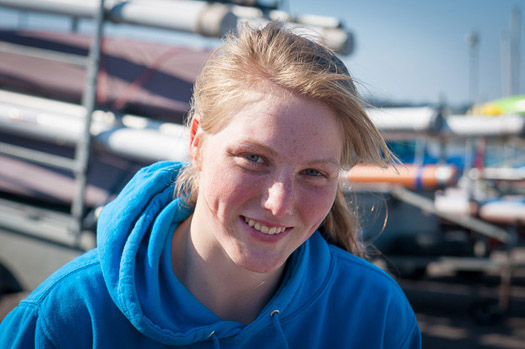

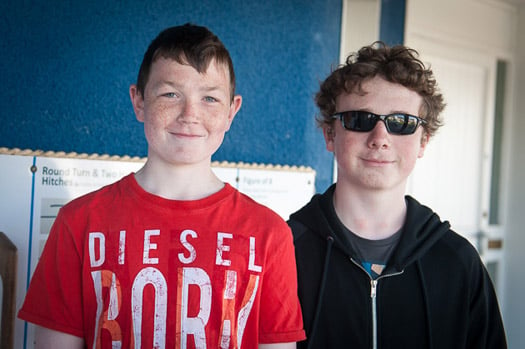
National 18s Take Dinghy Racing Class Onto A New Plane
#national18 – There are some special dinghy classes. There are some very special dinghy classes. And then there are the National 18s.
You can see any number of reasons why this unique class, celebrating its 80th birthday in just three years time, is in a league of its own. A three-man boat with one of the crew on a trapeze, its crewing set–up requires a level of sociability which is further emphasised ashore, where their après sailing is the stuff of legend.
At all the centres where it is sailed, and at places upon which the National 18s have descended for a championship, we know they've left behind a formidable reputation for determined but good humoured conviviality, combined with great sportsmanship.
Yet while it is easy to understand the class's popularity among its adherents when you see them in high spirits as a group, there's no getting away from the fact that in today's dinghy terms, 18ft is a lot of boat. The mood of the National 18s may often seem light-hearted. But keeping one of these boats in prime condition and well crewed is not something for the casually-interested.
It requires real commitment, yet that is something which National 18 sailors seem to have in spades. And now the class has taken on a new lease of life with the development of a fresh take on the National 18 parameters by legendary designer Phil Morrison. But rather than being launched as a commercial venture, the new boat is being developed from within class resources, which has involved several imaginative fund-raising ventures. W M Nixon found himself being drawn into one of them.
It's official, The Cork Harbour National 18 Class are brilliantly capable of running a booze-up in a distillery. And just to make it even more challenging for their supportive members and many friends, they ran this particular fund-raiser for the new Phil Morrison boat in the Jameson Distillery in Midleton in East Cork on the first Saturday night of Lent.
Of course, like all Ireland on St Patrick's Day three weeks later, they got a special dispensation for the partying to continue unhindered by thoughts of Lenten piety. There was plenty of time for that next morning. But meanwhile, right there in the heritage and high tech splendour of the Midleton facility where tradition and new science are dynamically allied, the National 18 crews went at it good-oh, and the class's Development Fund was greatly enhanced.
In fact, I'm told the financial targets were comfortably exceeded, but as Class President Dom Long and the ever-energetic Tom Dwyer didn't tell us the targets in the first place, we'll happily take their word for it. All I know is that it was one helluva night, and only the National 18s could have done it.

Let's party! Colman Garvey's vintage National 18 welcomes guests to the Midleton Distillery for yet another event in a series of fund-raisers which have supported the development of the new boat from within class resources. Photo: W M Nixon
It's a class which – thanks to being a restricted design rather than a hidebound one-design – is able to wallow happily in its history as it thrusts towards new designs which keep up the spirits of its established sharpest sailors, while also encourage the vital new blood.
So how did it all come about? Well, thanks to a prodigious book written by Brian Wolfe of the boat's history, published in 2013 to mark the class's 75th Anniversary, we get some idea of the inevitable complexity of the story. The class started in 1938 in the Thames Estuary where there'd been several local one design or restricted "large dinghy" classes around the 18ft mark and soon – under a National Class imprimatur from the Yacht Racing Association – it spread to several other centres.
Needless to say, World War II from 1939 to 1945 brought any further growth and most sailing activity to a halt, but by 1947 things were looking up again, and in the straitened post war circumstances, the National 18 found its niche. Back in 1938, Yachting World magazine had sponsored a design to the class's rules by Uffa Fox, and that became the clinker-built Uffa Ace, which continued to be the backbone of the class for many years after the war.
It was Whitstable in the far east of Kent which produced most of the initial impetus for the class, and local builders Anderson, Rigden & Perkins made a speciality of it. In fact, ARP-built Uffa Aces were soon virtually the definitive National 18. Yet ironically we cannot confirm at the moment if the oldest National 18 still sailing – Richard Stirrup's 1938-vintage Tinkerbelle which races with the classics divison at Bosham SC on Chichester Harbour – is an ARP boat.
It's ironic because Tinkerbelle's first home port was Howth. It wasn't until I was writing the history of Howth YC for its Centenary twenty years ago that awareness surfaced that there'd been the nucleus of a National 18 class in Howth in 1938.
There were just three boats – John Masser's Wendy number 14, Tinkerbelle number 15, and Fergus O'Kelly & Pat Byrne's Setanta, number 16.

Tinkerbelle (15) being sailed by Aideen Stokes in 1939, with John Masser's Nat 18 Wendy (later Colleen II) astern, and the Corbett family's Essex OD Cinders abeam.
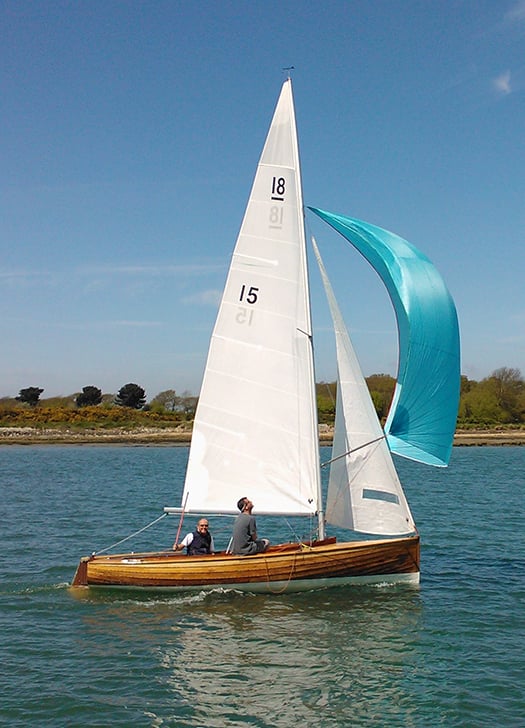
Tinkerbelle as she is today, the oldest National 18 still sailing. Her home port is Bosham on Chichester Harbour. Photo courtesy Richard Stirrup
Tinkerbelle seems to have been owned by a syndicate in which the Stokes family was much involved, though in the class history her earliest owner is listed as Bobby Mooney, son of the renowned Billy Mooney of Aideen fame. However, around Howth, Tinkerbelle was best remembered for being raced with considerable panache by a non-owner, Norman Wilkinson.
But when Norman returned from war service in 1946 determined to sail just as much as humanly possible, he found that the National 18s had faded away, and the only way he could get regular racing was by buying the 1898-built Howth 17 Leila, which he duly raced with frequent success right up to the end of his long life in 1998, by which time Leila was a hundred.
It's intriguing to think that, with one or two twists of fate in Howth, Norman Wilkinson might have been renowned as a star of the National 18s taking on the likes of class legends such as Somers Payne and Charlie Dwyer of Cork, where the class – having started with just two ARP boats in1939 - held fire for a while, but got going big time in the late 1940s and early '50s with several builders all round Cork Harbour creating them in local workshops.
That was one of the attractions of the National 18s. They were big enough to appeal to people who didn't fancy skittish little dinghies, yet they were small enough to be constructed by artisan boatbuilders who could produce lovely boats. But the owners – having laid out what were considerable sums of money at a time when Ireland seemed to be in a state of permanent economic depression – were disinclined to go the final stage of having the boats properly measured and registered with the class. This caused increasing problems, ultimately solved by a high level of diplomacy as the National 18s' popularity grew, and the opportunities arose for the Cork boats to go across the water to race in big-fleet competitions.
At one stage, class numbers were so healthy at many centres that in Britain they had Northern and Southern Championships, reflecting the primitive state of road movement of boats. Dinghy road trailers – particularly for hefty big 18-footers – were still in their infancy, so all sorts of ingenious methods were used to get boats to distant events, with a Whitstable boat on at least one occasion getting to Cork as deck cargo aboard a Coast Lines vessel on its regular route which took in Rochester in Kent and eventually Cork among several ports.

The National 18s in their classic prime, with immaculately vanished clinker-built hulls, and setting lovingly-cared-for cotton sails. Here, Crosshaven's greatest National 18 sailor Somers Payne (Melody, 206) is being pursued by Alan Wolfe in Stardust 63), while up ahead Charlie Dwyer with Mystic (208) is doing a horizon job, with the legendary Leo Flanagan of Skerries lying second at the helm of Fingal. The photo was taken during a Dinghy Week at Baltimore, and it is memories like this which inspired Brian Wolfe (son of Stardust's owner-skipper) to undertake the mammoth task of collating and writing the class's history.
In Ireland, centres which saw interest in the National 18s included Dunmore East, Clontarf and Portrush, but as Dun Laoghaire was committed to the 17ft Mermaid, the only place on the East Coast with really significant National 18s numbers was Skerries, where the incredible Leo Flanagan set the pace driving his Jensen Interceptor ashore, and racing his no-expenses-spared ARP-built National 18 Fingal afloat in somewhat erratic style.
Leo was a ferocious party animal, and when the Skerries and Crosshaven National 18s united in going to the big class championship at Barry in South Wales in the mid 1950s, Leo was very disappointed to discover that, just as the party was really getting going, the club barman had every intention of closing at closing time. The very idea....Leo solved the problem by buying the entire bar for cash on the spot.
As far as Leo was concerned, sailing was for parties, so when he heard of the highly-organised Irish Olympic campaign towards the 1960 Olympics in Rome, he got himself to Rome, as Olympic sailing promised Olympian parties. To his distress, he was ordered out of the Olympic Village by the Irish squad, who wanted no distractions. But to their distress, the bould Leo then turned up next morning for the first day's racing, officially accredited and highly visible in his new role – he had become manager of the Singapore team.
It seems that in a harbourside bar the night before, he'd met the helmsman of the Singapore Olympic Dragon (as it happened, the only Dragon in Singapore), who was racing in the Olympics as a personal venture. As the biggest rubber concessionaire in Malaya, he could well afford to do so. But this meant he was also Team Manager, and when Leo met him, the Singapore skipper was much upset, because with his sailing duties and need to get a good night's sleep before each day's racing, he was simply unable to take up all the official invitations which any Olympic Team Manager received.
He felt he was badly offending his hosts, and completely failing the Singapore sailing community So Leo, out of sheer kindness, agreed to be the Singapore Olympic Sailing Team Manager, giving selflessly of his time, energy and great wit in the front line at all the best and most fashionable parties throughout the 1960 Olympic Regatta.
All of which has little enough direct connection with the story of the National 18s, but it gives you some idea of the style of the people who have been involved in a long tale which will soon have been going on for eighty years. Yet beyond the parties and the many scrapes they got into, there was also much serious sailing and boat development going on, for although the Uffa Ace was the most numerous design in the growing fleet, anyone could have a go provided they fitted within the class rules.
But by the mid-1960s, it was clear that the traditional concept of a clinker-built National 18 was losing its appeal, and in 1968 the Class Association asked Ian Proctor to design a National 18 to be built as a smooth-hulled fibreglass series-produced boat, with bare hulls to be available for owners who wished to finish the boats themselves.
However, being mindful of keeping existing wooden boats competitive, the new boats were built much heavier than their glassfibre construction really required. Yet they looked good, and the first one Genevieve (266) was delivered to class stalwart Murray Vines, who sailed with the Tamesis Club on the Thames. There, the river may have been pretty, but it was so narrow that when the Tamesis people secured a major championship, they took their entire race management team down to the coast to attractive sea venues where the National 18s could do their thing with style and space.
That said, it was far from style and space they were reared. Murray Vines' son Jeremy – who is proud owner of the very first production version of the Phil Morrison Odyssey design which the class has been developing for the past two years – recalls his own earliest experience of championship competition with the National 18s in 1949 aged 11. He and his brother crewed for their father in 18/51 in a championship on the Medway in Kent, and they lived afloat on the boat, for in those days many National 18s lay to moorings.
Perhaps as a reward, the father built the two young Vines brothers their own International Cadet Dinghy the following winter. But Jeremy has remained loyal to the National 18 class to the point of being the pioneering owner for the new version of the design despite being at a certain age which you can work out yourself from that data given for the Medway in 1949. That said, he has given himself more space for his sailing as he has moved his base from Tamesis to Lymington, and in addition to the National 18, he cruises and races the Dufour 34 Pickle, a sister-ship of Neil Hegarty's award-winning Shelduck which featured in this column a week ago.
That the new wave of glassfibre 18s was not going to outclass the existing boats was forcefully demonstrated in 1970, when the class held its first combined all-British & Irish Championship in Cowes, after twenty years of separate Northern and Southern events. Despite the new glassfibre boats, the classics from Cork Harbour – where they'd been in the midst of celebrating the Quarter Millennium of the Royal Cork YC - were dominant, with Somers Payne right on top of his form sailing Melody (206) to win going away, notching only 1.5 points to second-placed clubmate Dougie Deane on 14.
Cork Harbour boats took the first six places in a crack fleet of thirty-one of all the best from every top National 18 centre, and the spirit of it all was best captured by the Thames Challenge Cup for a family crew going to Royal Cork's Dwyer family – Charlie and his sons Michael and a very young Tom – who placed sixth in Mystic.
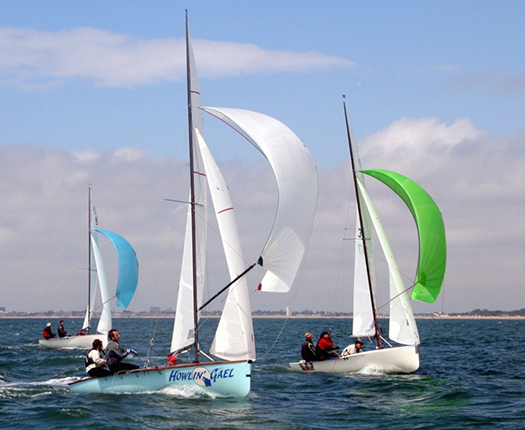
The furthest flung fleet is at Findhorn in northeast Scotland, but the huge distance involved doesn't stop Royal Findhorn YC boats competing with the rest of the class. This is top RFYC helm Stuart Urquhart's Howlin Gael racing in the Solent, and every so often the class – including those from Cork – make the long trek to Finhorn for an annual championship.
However, in terms of championship success the movement towards overall victory by glassfibre boats had begun, and 1977 saw the last championship win by a wooden boat, with Mike Kneale's Maid Mary (183) from the Port St Mary fleet in the Isle of Man. This was a hotbed of National18 racing for a couple of decades, and after Mike had completely renovated the 23-year-old formerly only so-so Maid Mary, he clinched the 1977 title at Findhorn in northeast Scotland "just before you get to Norway", as I was told in Midleton last month. There, the Royal Findhorn YC is a byword for warm hospitality ashore and hot sport afloat, but despite a strong challenge by a formidable Cork contingent, the Manxmen won out.
But having done his duty by the classic wooden boats, for 1979 Mike Kneale and his team took a different tack – they commissioned a new National 18 design from ace ideas man Jonathan Hudson, which they composite-built around Airex foam whose use other Manx DIY boat builders such as Nick Keig had been deploying for long-distance multi-hulls.

The Airex boat....Mike Kneale's innovative Woodstock on trials off Port St Mary in the Isle of Man in 1979.
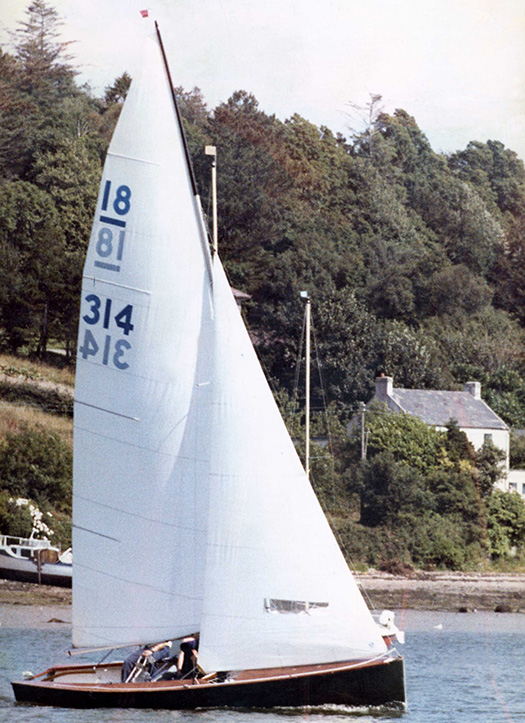
Woodstock from the Isle of Man sails back into Crosshaven in 1979 with all the look of a boat which has just won the championship.
Despite – or maybe because of – her composite materials, the new boat was called Woodstock. And as Brian Wolfe's history of the class recalls, when she appeared for the well-supported 1979 championship in Crosshaven, "there was much debate", not un-related to the fact that Mike and his crew of Rick Tomlinson and Ross Thomas swept the board, taking the championship for Mike's fourth time in a clean sweep with the top boat from the home Cork Harbour fleet being Albert Muckley's Eastern Promise (323) in second overall for East Ferry SC.
So where was Somers Payne? Well, after dominating the national championship leaderboards since 1958 with the wooden Melody, in 1979 Somers was making his first foray into campaigning a glassfibre boat, and while he may have been third, the writing was on the wall, and the class was moving to class.
And there was new life at Royal Cork. The Royal Cork YC's National 18s were having one of their periodic re-births, and while Woodstock may have won the title, her designer reckoned it was only by extra skill that they stayed ahead of a new wave of young talents whose helming skills had been honed in events like the Admiral's Cup and many national and international championships in all sorts of boats. Their zest for international competition was buoyed up by the knowledge that, back home in Crosser, they had ready-to-go racing in the National 18s which was not only great sport, but somehow much more fun than sailing in other boats.
This continued level of enthusiasm at all ages meant that when the National 18 pace showed any signs of slackening, the Cork Harbour division could be relied on to get things up and moving again. Thus when the changeover to glassfibre had become complete at the front of the fleet, with many other owners happy to race their vintage boats in a classics division, some of the Corkmen questioned why new glasfibre boats were still being built overweight in order not to out-perform boats which now saw themselves as a different part of the class in any case.
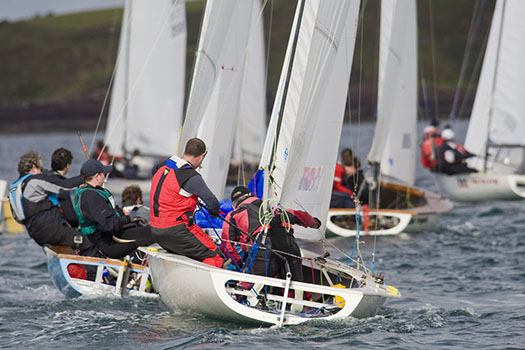
The National 18 fleet in Cork Harbour was mustering serious numbers with the lighter GRP boats from O'Sullivan's of Tralee. Photo: Bob Bateman
So the Crosshaven people got the moulds from England, and encouraged the moving of them to O'Sullivan's Marine in Tralee (incidentlally just about as far west on land as you can get from Whitstable in Kent), where they were used to build a whole new wave of lighter boats which became the National 18 class as most of us have known it until this year. Now, the new moves into the Phil Morrison boat are providing a fresh direction for a class which nevertheless takes careful steps to ensure that older boats have their place in the sun with a chance of realistic racing against similar craft.
Although Jeremy Vines of Tamesis and Lymington is the owner of the first of the new boats (she's number 401, and is called Hurricane in honour of the very first National 18 built by Anderson, Rigden and perkins in Whitstable in 1938), he is untinting in his praise for the energy and vision of the Cork harbour division of the class in having the idea and then promoting the new Phil Morrison boat, and he makes a particular point of applauding the very tangible support which has been given to the project by the Royal Cork Yacht Club.
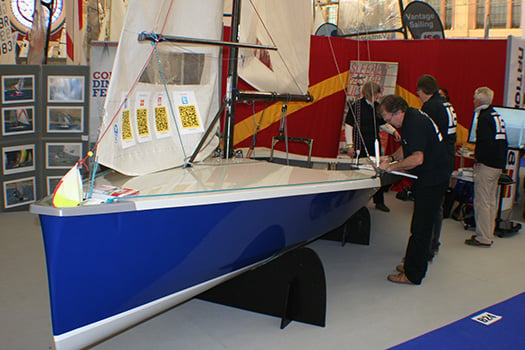
Into the blue.....Hurricane (number 406) is unveiled a fortnight ago at the Dinghy Show.
It's almost unfair, in such a community-based grass roots project, to single out anyone for special praise, but I got the feeling that folk like Colin Chapman, Dom Long and Tom Dwyer have been right there in the thick of it from the beginning.
The prototype having been tested and approved every which way, the moulds were made and the first dark blue hull emerged early in the New Year in one of the workshops which Rob White runs at White Formula Boats at Brightlingsea in Essex. So having been built at Tralee on the shores of the Atlantic for more than a decade, National 18 production is now back on the shores of the North Sea, but the spirit of the class at every location, regardless of where it might be, seems keener than ever.
The first of the new boats - of which sixteen have now been ordered – was Jeremy Vines' Hurricane, number 406, which was unveiled at the recent Dinghy Show in London. For a new generation which has been raised on the Phil Morrison-designed RS 200, this latest variant on the continuing National 18 story will speak volumes, and with eloquence. But it says everything about the spirit of this exceptional class that she rings a bell with seasoned National 18 sailors too.

The gang's all here. The new boat celebrated at the Dinghy Show with a group including many of those actively involved in its development, notably Colin Chapman, Tom Dwyer, Dom Long and Jeremy Vines.
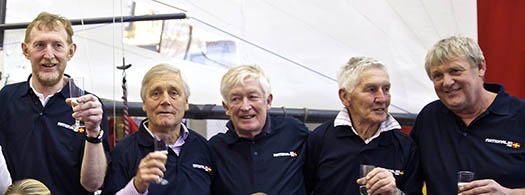
The movers and shakers are (left to right) Tom Dwyer of the Cork Harbour National 18s, designer Phil Morrison, Cork Harbour Class President Dom Long, Jeremy Vines (owner of the first boat to the new Morrison design), and Rob White of White Formula Boats
O'Leary Seventh in Viper Class At Bacardi Miami Sailing Week
#royalcork – At Bacardi Miami Sailing Week, Royal Cork's Anthony O'Leary – who was crowned Afloat's Sailor of the Year on Friday – has finished seventh overall in the 32-boat Viper fleet. Racing with Howth's Dan O'Grady and Cork clubmate Tom Durcan, the sole Irish trio's best individual result was a fourth which they achieved twice in races two and six of the nine race series. Full results here.
Canadian Brad Boston on Jackpot took home the win with 22 points followed by Peter Beardsley (24 points) and Geoffrey Ewenson (26 points) both from the United States. "Perfect Miami conditions," said Brad Boston. " Started light, built up after race one and finished good. We sailed all week in just tee shirts, that alone is unbelievable! It came down to the last race in order to decide the series and it was nerve wrecking because at some point we lost track of the situation and we really didn't know where we were in terms of points.
Royal Cork Retains Five Gold Anchor Marina Status
#royalcork – Royal Cork Yacht Club has retained its Five Gold Anchor Marina award as well as an ICOMIA (International Council of Marine Industry Associations) Clean Marina Award.
The Royal Cork became the first Yacht Club in Ireland to be awarded this prestigious title in 2011 and further to a recent inspection, the Club has again retained this status. Ratings range from one to five gold anchors and for the Royal Cork to attain the maximum number of anchors again is a fantastic achievement by all of the Club staff involved.
Preparations for a busy summer of visiting yachts from all corners of the globe and organisation for some of Ireland's most prestigious sailing events are well under way. Gavin Deane, General Manager commented "This year is gearing up to be a busy one for the Club and retaining our Five Gold Anchors was a fantastic way to start 2015. Through our involvement in the Gold Anchor scheme we hope to see an increase in our visitor numbers again this year which is great news for the Club and also for the local economy. In addition to hosting a number of high profile events this year, we hope to expand on our training offering for both children and adults. Last year the Club was awarded the Irish Sailing Association 'Training Centre of the Year' and we have witnessed a significant increase in numbers coming to try sailing for the first time"
Mark Ring, Racing & Marina Co-ordinator at the Royal Cork, who has qualified as a Certified Marina Manager since our last inspection commented "We are delighted to retain the coveted TYHA Five Gold Anchor Award in 2015. This award is very much a team effort and everyone's input is necessary both in preparing for inspection day and maintaining the five Gold Anchor standard, while upholding that essential customer service ethos. There is an enormous sense of pride amongst all of the staff that our members and visitors will receive excellent service and high standards at the Royal Cork Yacht Club under the THYA Five Gold Anchor scheme."
The Gold Anchor award scheme is a voluntary assessment programme focused on customer service and providing Quality Assured Berthing for any boat owner. The scheme is designed for the marina consumer by The Yacht Harbour Association with contribution from the RYA. With 26 years' experience of Gold Anchor standards, this is a point of reference for all boat owners to make an informed decision on where to berth.
Cork Sailors Hear About New ISA Plan For Irish Sailing
#irishsailing – The Irish Sailing Association SRG (Strategic Review Committee) penultimate meeting of the series took place last evening at the Rochestown Park Hotel, Cork and drew an excellent attendance with a large number of representatives from southern clubs and sailing establishments in attendance and sailing instructors were also well represented. Claire Bateman reports.
The meeting was chaired by former RCYC Admiral David O'Brien, Dublin SRG representatives who travelled were Brian Craig and former ISA Presidents Neil Murphy and Roger Bannon, and Harry Hermon of the ISA.
A full copy of the ISA Strategic plan until 2020 can be found here.
The meeting commenced at 7pm with an introduction by David O'Brien followed by Neil Murphy who took the meeting through the Strategic Plan line by line. The attendance had been requested to hold questions until the presentation was complete and this request was duly complied with. The Q & A session began at approximately 8.50pm with the meeting scheduled to finish at 9pm. People had a lot of points to make and the meeting finally concluded at approximately 9.45pm.
It could have been a meeting from some twenty years ago and this was no bad thing. Some very old chestnuts were still being aired along with some new topics and indeed some views being expressed from the top table were still unchanged from former years. As one would expect from the wonderful cruising areas in the south west, cruising got a good airing from several quarters with changes being requested in recognition of the importance of this branch of sailing. Also, the importance of motor boating was raised with the rise in numbers of such craft now being seen and, indeed as pointed out by Vice Admiral John Roche of RCYC, there are now some thirty to forty such boats on the RCYC marina and other speakers pointed out this is reflected in clubs all around the country.
A thorny area drew huge response from the meeting and this was the situation regarding RYA courses. Currently RYA instructors are giving courses in this country and these instructors will in be working here and it was pointed out these courses are fully recognised outside Ireland while the ISA Instructor courses have no such recognition. The question of frequent compulsory revalidation also proved to be a hot topic and one that the Instructors have requested to be looked at. The lack of availability of qualified instructors also came up for discussion. The ISA Pathway also came up for discussion and is another area to be looked at.
The ISA's view on the question of promoting two person boats over single handed dinghies, desirable and all as the idea may be to some people, came into sharp focus in a week where a sell out mid term sail training week for Optimists in Baltimore SC is being attended by 150 Optimist sailors and their families from all corners of Ireland. Indeed, your scribe, residing near the main route to West Cork, could describe the numbers of vehicles travelling west complete with packed roof boxes and trailers piled high with all the gear while the car interiors showed parents, youngsters and in a lot of cases family mutts, all heading to a week of hard training for the enthusiasts and a fun week for the younger family members and hopefully for the parents and indeed for the village of Baltimore. By all accounts this is exactly what is taking place.
There was a view put forward from the top table that an Optimist sailor coming out of the ranks when it was time to move on would have no knowledge of sailing coming out of a "little box of a boat". Here I have to disagree strongly. Now, I am no great Optimist fan but I have watched these sailors and their knowledge of sailing can be quite fantastic and their experience of different sails in knowing what is needed for different weights and conditions is absolutely tremendous. They go to sea in conditions that leave the rest of the fleets high and dry and enjoy themselves experiencing conditions the experienced hardy annuals would baulk at. Pay a visit to the Royal Cork Yacht Club during any school holidays and you will find the Oppie Skippers sailing anything and everything they can get their hands on. They will go out in Topaz, 420's, Fevas, International 14's, Toppers, you name it and they will be found.
They also join the club racing/cruising fleets as crew and can be found doing on board crew tasks on the these boats and will also helm. Where did Sir Ben Ainslie commence his sailing career? In an Optimist of course. Last word on this, on one occasion when the ISA were really pushing two person boats, one in particular, the parents responded by deciding to buy Laser 2's in large numbers against the recommendation of the ISA. A world championship for these boats was held in Crosshaven with large numbers in attendance. Where are they now?
The appreciation for the hard work of the SRG Committee was expressed by all and the members thanked for coming to Cork. The last meeting of the series will be held in Galway and the final item on the SRG agenda for the moment will be to try to ensure the adoption of the SRG Plan. If sailors have strong views to express they should make the effort to be present at the Maldron Hotel, Portlaoise at 11.30am on March 28th. If you are not there you cannot complain afterwards if an item was passed you did not agree with without at least having the chance to express your opinion.
A good humoured meeting at the Rochestown Park Hotel in Cork and devoid of any real controversy.



























